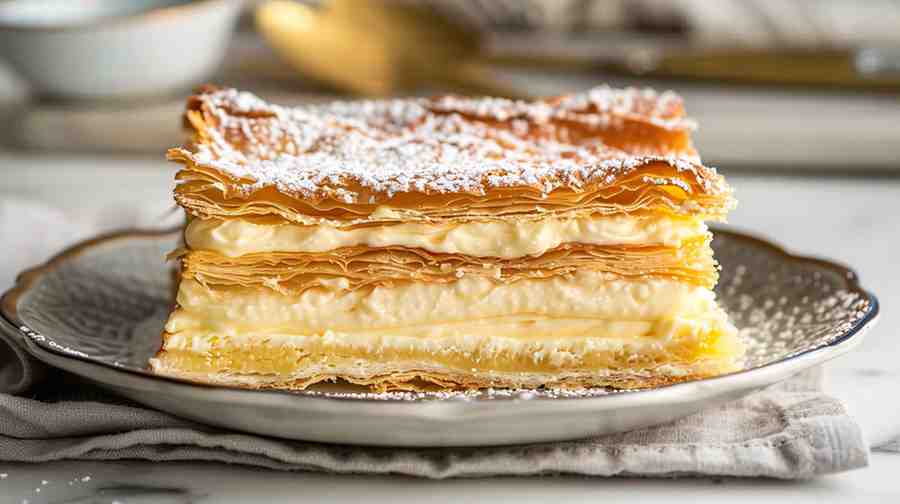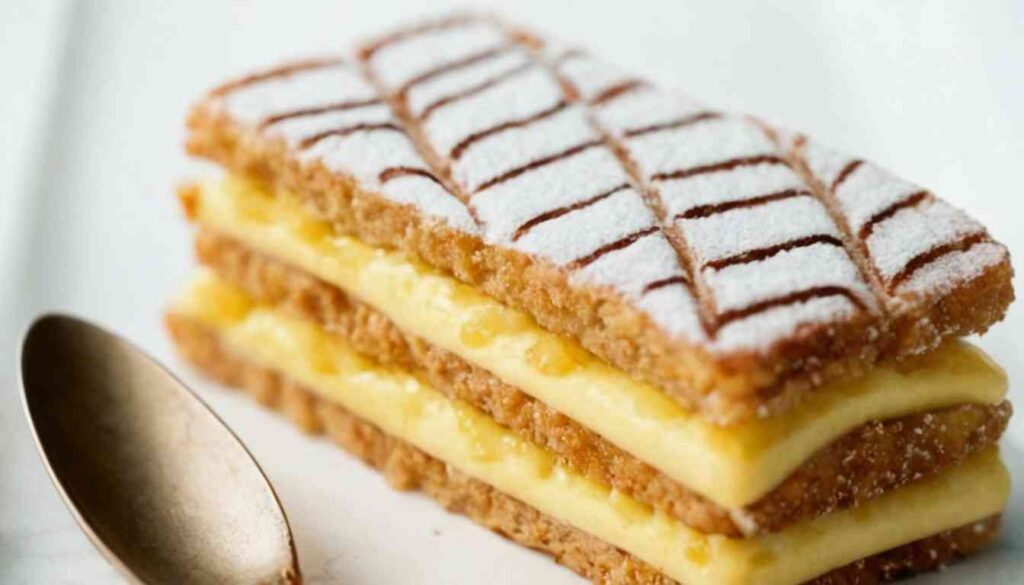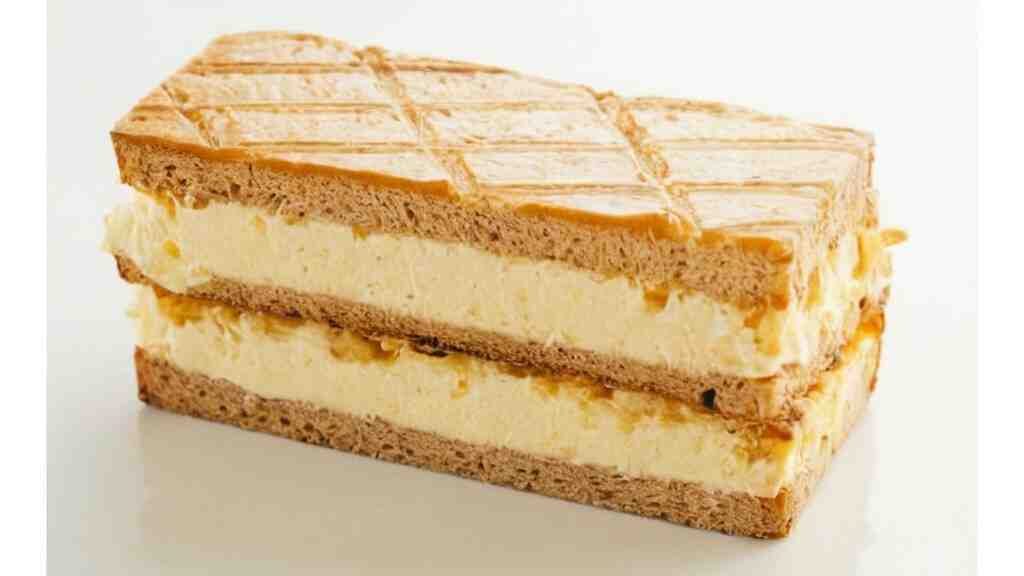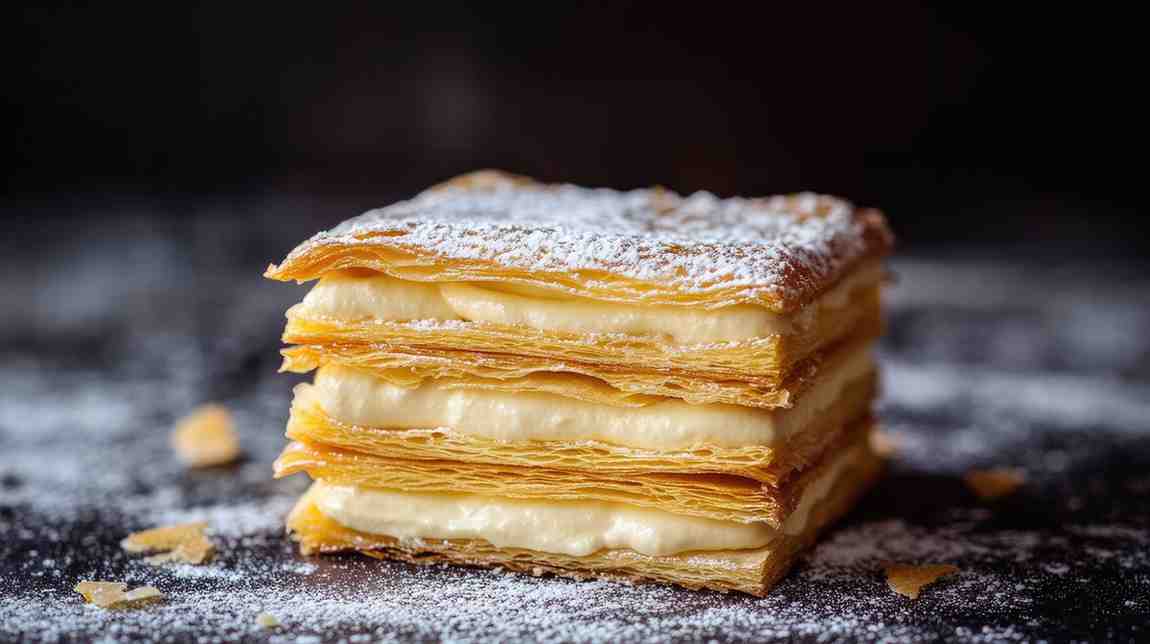Mille-Feuille Cake, also known as “Napoleon” or “custard slice,” is a quintessential French pastry that has delighted dessert lovers for centuries. Characterized by its thin, crispy layers of puff pastry and smooth, creamy fillings, this dessert is a symbol of French patisserie excellence. In this guide, we’ll explore its origins, components, and what makes it so special.
The History of Mille-Feuille
The mille-feuille dates back to the 17th century and was first mentioned in French culinary texts. Over time, it has become a beloved dessert not just in France but across the globe.
Key historical facts:
- 17th-century origins: Mille-feuille was initially designed as a multi-layered pastry with cream, intended to be a special occasion treat.
- Name meaning: “Mille-feuille” translates to “a thousand leaves,” representing the numerous layers of puff pastry.
- Global variations: Known as “Napoleon” in some countries and “custard slice” in the UK, reflecting regional interpretations.
Why the Name “Napoleon”?
In various countries, mille-feuille is called Napoleon, but there is no clear consensus on why. Some believe it refers to the French military leader, while others suggest it comes from “napolitain,” referencing Naples. Regardless, the dessert’s fundamental structure remains the same—flaky pastry and a rich cream filling.
Essential Components of Mille-Feuille
Mille-feuille’s charm lies in its delicate combination of crisp pastry, creamy fillings, and decorative icing. Each element plays a crucial role in delivering the perfect texture and flavor.
Puff Pastry: The Heart of Mille-Feuille
The foundation of a Mille-Feuille Cake is its puff pastry. This delicate pastry is made by folding butter into dough, creating thin layers that puff up during baking to become crisp and golden.
Important tips:
- Homemade vs. store-bought: While homemade puff pastry offers better taste and texture, store-bought pastry is a convenient option.
- Docking the pastry: Prick the pastry with a fork before baking to prevent excessive puffing.
- Weighing it down: Use pie weights or dried beans during baking to keep the layers flat and even.
Steps for preparing puff pastry:
- Roll out the dough: Thinly roll out the puff pastry to about 1/8 inch thick.
- Dock it: Use a fork to poke holes throughout the surface to control puffing.
- Bake with weights: Cover the pastry with parchment paper and place weights on top. Bake at 400°F (200°C) for 20 minutes, then remove the weights and continue baking until golden brown.
Pastry Cream: The Lush Filling
Pastry cream, or crème pâtissière, is the classic filling for mille-feuille. This thick custard-like filling provides a smooth contrast to the crisp pastry. It’s traditionally flavored with vanilla but can be customized with other flavors like coffee or chocolate.
Common filling options:
- Crème pâtissière (Pastry cream): A classic custard made with milk, eggs, sugar, and vanilla.
- Crème légère: A lighter version made by folding whipped cream into pastry cream.
- Flavored creams: Options include chocolate, fruit-infused creams, or even coffee-flavored cream.
Steps for making pastry cream:
- Whisk egg yolks and sugar: Combine egg yolks, sugar, and cornstarch in a bowl.
- Heat the milk: Slowly heat milk and sugar in a saucepan until simmering.
- Temper the eggs: Gradually pour the hot milk into the egg mixture while whisking to prevent curdling.
- Thicken: Return the mixture to the heat, cooking until thickened, then chill.

Decorative Icing: The Finishing Touch
The marbled icing is what makes mille-feuille visually stunning. This classic design is created by layering a simple vanilla glaze and piping lines of chocolate over it, then using a toothpick to create the signature chevron pattern.
Variations for decorating:
- Vanilla and chocolate icing: The most traditional choice, combining the sweetness of vanilla with the richness of dark chocolate.
- Alternative toppings: Powdered sugar dusting, royal icing, or even fresh fruit.
Steps for icing:
- Prepare vanilla icing: Mix powdered sugar, vanilla, and a little milk until smooth.
- Melt chocolate: Pipe lines of melted chocolate across the vanilla icing.
- Create marbling: Drag a toothpick through the chocolate lines to form the chevron pattern.
Why Mille-Feuille Stands Out
What makes mille-feuille different from other desserts is its perfect balance of textures. The crispness of the puff pastry, the softness of the cream, and the sweetness of the icing all come together harmoniously.
Key highlights:
- Multiple textures: A combination of crispy pastry, creamy filling, and sweet icing.
- Aesthetics: The marbled icing adds an elegant, artistic touch.
- Flavor balance: The rich cream contrasts with the light, flaky pastry, offering a delightful taste experience.
Mille-Feuille vs. Other Puff Pastry Desserts
Though mille-feuille shares its puff pastry base with many French desserts, it is unique in its assembly and flavor profile.
Mille-Feuille vs. Croissants
Croissants are more focused on creating an airy, layered dough that rises significantly during baking, while mille-feuille is flat and meant to be crisp.
Key differences:
- Croissants: Light, airy dough, often filled with sweet or savory ingredients.
- Mille-feuille: Layered with pastry cream and meant to stay flat and crispy.
Mille-Feuille vs. Éclairs
Éclairs use choux pastry, which is lighter than puff pastry and is typically filled with cream or custard after baking.
Key differences:
- Éclairs: Use choux pastry, which rises and is filled post-baking.
- Mille-feuille: Stacked with pastry cream between crisp pastry layers.
How to Serve Mille-Feuille
Mille-feuille is typically served chilled, as the cool temperature helps the cream set and keeps the pastry layers firm.
Serving tips:
- Cutting technique: Use a sharp serrated knife to slice through the layers cleanly.
- Pairing: Mille-feuille pairs well with tea, coffee, or even dessert wines.

Popular Variations
Although the traditional mille-feuille is delicious, there are many ways to put your own twist on this classic.
Popular variations:
- Fruit-filled mille-feuille: Add thin slices of strawberries or raspberries between the layers of cream.
- Chocolate mille-feuille: Use chocolate mousse instead of vanilla pastry cream for a richer version.
- Caramel mille-feuille: Drizzle caramel between the layers for a sweet and salty combination.
Ingredients List
Gathering all your ingredients before you start will help streamline the baking process and ensure smooth preparation.
For the Puff Pastry:
- 2 sheets of store-bought puff pastry (thawed) or homemade puff pastry.
- Flour for dusting.
For the Pastry Cream:
- 2 cups whole milk.
- 4 large egg yolks.
- 1/2 cup granulated sugar.
- 3 tablespoons cornstarch.
- 1 tablespoon unsalted butter.
- 1 teaspoon vanilla extract (or seeds from 1 vanilla bean).
- Optional: 1/2 cup heavy whipping cream (for a lighter filling).
For the Icing:
- 1 cup powdered sugar.
- 1 tablespoon milk (adjust for consistency).
- 1/2 teaspoon vanilla extract.
- 2 ounces dark chocolate (melted for decoration).
Step-by-Step Guide to Making Mille-Feuille
The process of making mille-feuille is best broken down into steps. By following these steps carefully, you’ll ensure everything turns out perfectly. First, we’ll start with the puff pastry, then move on to the pastry cream, and finally, assembling and decorating your mille-feuille.
1. Prepare the Puff Pastry
The puff pastry forms the foundation of your mille-feuille. Here’s how to ensure it comes out crisp and golden.
- Roll out the dough: On a lightly floured surface, roll the puff pastry until it’s about 1/8 inch thick.
- Dock the pastry: Prick the dough evenly with a fork to prevent it from puffing excessively during baking.
- Weigh it down: Place a sheet of parchment paper on top of the pastry, then add a second baking sheet or pie weights to keep it flat.
- Bake: Preheat your oven to 400°F (200°C). Bake the pastry for 20 minutes, then remove the weights and parchment. Continue baking for another 7-10 minutes, until the pastry turns golden brown and crisps up nicely.
- Cool completely: After baking, let the puff pastry cool on a wire rack.
Pro Tip: If you’re using homemade puff pastry, make sure to keep it cold between rolling and folding to maintain the layers for maximum flakiness.
2. Make the Pastry Cream
As the puff pastry cools, it’s time to prepare the pastry cream, which will be the luscious filling between the layers.
- Whisk egg yolks and cornstarch: In a large bowl, whisk together the egg yolks, cornstarch, and half of the sugar. Continue whisking until smooth and pale.
- Heat the milk and sugar: In a medium saucepan, heat the milk and remaining sugar over medium heat. Stir until the mixture just begins to simmer.
- Temper the eggs: Slowly pour the hot milk into the egg mixture while whisking constantly. This gradual addition will prevent the eggs from curdling.
- Thicken the cream: Pour the mixture back into the saucepan and cook it over medium heat. Keep whisking until the mixture thickens into a custard-like consistency, which should take around 2-3 minutes.
- Add butter and vanilla: Once off the heat, stir in the butter and vanilla extract to add a rich flavor and smooth finish to the cream.
- Chill the pastry cream: Transfer the pastry cream into a bowl, covering the surface directly with plastic wrap to prevent a skin from forming. Refrigerate it for at least 3 hours to let it set properly.
Optional: For a lighter texture, whip 1/2 cup of heavy cream and gently fold it into the cooled pastry cream before assembling the layers.
3. Assemble the Mille-Feuille
Once the puff pastry has cooled and the pastry cream has set, you can begin assembling the mille-feuille. This step brings everything together, so take your time to ensure clean, precise layers.
- Cut the pastry: Using a sharp serrated knife, trim the puff pastry into evenly sized rectangles or squares. You’ll need three pieces for each mille-feuille.
- Layer the pastry and cream: Place the first layer of puff pastry on a flat surface. Pipe or spread an even layer of pastry cream over it. Gently press the second layer of puff pastry on top, and repeat the process with more cream. Finally, add the third and final layer of puff pastry on top.
- Refrigerate: After assembling, refrigerate the mille-feuille for about 30 minutes. This allows the cream to firm up and helps the layers stay stable when slicing.
Pro Tip: For precise and even layers, use a piping bag to apply the cream, which will give you more control and prevent the layers from sliding apart.
4. Prepare the Marbled Icing
The marbled icing is the hallmark of a traditional mille-feuille, giving it that iconic finish. Follow these steps to create a perfect decorative touch.
- Mix the vanilla icing: In a small bowl, whisk together the powdered sugar, milk, and vanilla extract until smooth. The icing should be thick enough to spread but not runny.
- Melt the chocolate: In a separate bowl, melt the dark chocolate. You can do this in the microwave in 20-second increments or over a double boiler until fully smooth.
- Ice the top layer: Spread the vanilla icing over the top pastry layer evenly.
- Create the marbling effect: Using a small piping bag or spoon, drizzle thin lines of melted chocolate over the vanilla icing. Then, drag a toothpick or small knife through the chocolate lines in alternating directions to create the signature marbled effect.
- Allow the icing to set: Let the icing set for about 15-20 minutes before cutting and serving the mille-feuille.
Pro Tip: If you don’t have a piping bag, you can make a small hole in the corner of a plastic sandwich bag and use it to pipe the chocolate lines.

Pro Tips for Success
To ensure your mille-feuille turns out perfectly, keep these helpful tips in mind:
- Chill between steps: After layering the pastry and cream, refrigerate the assembled mille-feuille for about 20-30 minutes. This helps the cream set and makes slicing easier.
- Use a serrated knife: A sharp serrated knife is ideal for cutting through the delicate layers without crushing them. Make sure to use a gentle sawing motion.
- Avoid sogginess: Serve the mille-feuille soon after assembling to keep the puff pastry from softening. If you must store it, keep it in the fridge uncovered to prevent moisture from ruining the crisp layers.
Creative Variations of Mille-Feuille
While the classic version is a favorite, you can also try different flavors and variations to suit your taste.
Fruity Mille-Feuille
- Add layers of thinly sliced fresh fruit, such as strawberries, raspberries, or peaches, between the layers of pastry cream.
- Consider using a fruit-flavored icing for a refreshing finish.
Chocolate Mille-Feuille
- Substitute the vanilla pastry cream with a rich chocolate mousse for a decadent dessert.
- Drizzle additional melted chocolate over the top layer for a more indulgent treat.
Caramel Mille-Feuille
- Layer salted caramel sauce between the puff pastry and cream for a sweet-and-salty flavor combination.
- Use caramelized puff pastry by sprinkling sugar over the pastry before baking for an extra touch of sweetness.
FAQs About Making Mille-Feuille
What can I use if I don’t have pie weights?
If you don’t have pie weights, you can use dried beans, uncooked rice, or even a second baking sheet to weigh down the puff pastry. These alternatives work well to keep the layers from puffing too much.
How do I keep the puff pastry crispy?
To maintain the crispness of the puff pastry, it’s best to assemble the mille-feuille just before serving. If you need to make it ahead of time, store it uncovered in the refrigerator, which helps prevent the puff pastry from becoming soggy due to the cream.
Can I make mille-feuille in advance?
Yes, you can prepare the components ahead of time. Bake the puff pastry and make the pastry cream the day before. However, it’s best to assemble the dessert shortly before serving to keep the layers crisp.
Can I use different fillings for mille-feuille?
Absolutely. While vanilla pastry cream is traditional, you can experiment with chocolate mousse, whipped cream, or even fruit-flavored custards to add a unique twist.

